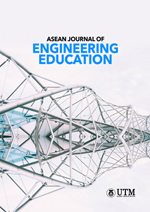Design of First Year Integrated Courses based on Constructive Alignment
DOI:
https://doi.org/10.11113/ajee2020.4n2.7Keywords:
Constructive alignment, student centred learning, introduction to engineering, Industrial Seminar & ProfessionAbstract
A design of chemical engineering 1st year integrated courses based on constructive alignment is presented. Introduction to Engineering (ITE) course is designed to stimulate students’ passion, strengthen their motivation, as well as enhancing their technical knowledge and relevant professional skills. ITE course is integrated with an Industrial Seminar and Profession (ISP) course to support the inclusion of stakeholders by inviting them to give
presentations and bringing students for related site visits. Although the ISP is a one-credit course, it is very important to plan and execute the activities hand-in-hand with the ITE course. In this study, reflection and meta-reflection journals which have been designed to integrate both courses have been analysed thematically to evaluate students’ response on the integration part. Besides that, other activities in ISP such as workshops, industrial visit etc that are
integrated with the design and implementation of cooperative problem based learning (CPBL) activities in ITE are highlighted and discussed. All of the above mentioned integrated CPBL are constructively aligned to achieve both course and program outcomes. Such integrated CPBL activities following constructive alignment saves time and effort among lecturers to fulfil the course and programme objectives.


















